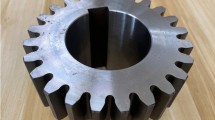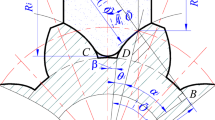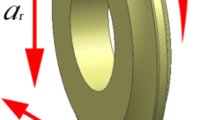Abstract
In this study, the thermal model of the creep feed deep profile (CFDP) grinding process of a small-module gear was established regarding the spatial interaction between the workpiece and grinding wheel, as well as the thermal boundary and the energy partition. A 3D dynamic finite element simulation of small-module gear CFDP grinding was carried out by utilizing the element birth and death technique. The validation experiments aided the specially designed thermocouples in that the grinding temperature on both sides of the tooth groove could be measured simultaneously, which demonstrated a satisfactory agreement with the experimental findings. The average difference was approximately 10%, which proved the feasibility and accuracy of the simulation. The effects of three possible geometric structures for both sides of the tooth groove being processed on the grinding temperature distribution were discussed based on the validated finite element model. This study is expected to enhance comprehension of the temperature distribution in the CFDP grinding of a small-module gear and offer recommendations for optimizing the process parameters in the precision machining of a small-module gear.















Similar content being viewed by others
References
Zhu W-B, Li J-Z, Ye S-L (2017) Research on sub-pixel registration of fine-pitch gear image based on SIFT. Chin J Sci Instrum 38(09):2326–2334
Xu M, Feng Y-M, Du G-M, Zhao X-L (2014) Analysis and prevention on grinding burn of small modulus hardened gear. J Mech Transm 38(07):127–130
Gu Y, Li H, Du B et al (2019) Towards the understanding of creep-feed deep grinding of DD6 nickel-based single-crystal superalloy. Int J Adv Manuf Technol 100:445–455
Miao Q, Ding W, Kuang W et al (2020) Tool wear behavior of vitrified microcrystalline alumina wheels in creep feed profile grinding of turbine blade root of single crystal nickel-based superalloy. Tribol Int 145:106144
Qing M, Wenfeng D, Kuang W et al (2021) Grinding force and surface quality in creep feed profile grinding of turbine blade root of nickel-based superalloy with microcrystalline alumina abrasive wheels. Chin J Aeronaut 34(2):576–585
Chen J, Fu Y, Qian N et al (2021) Investigation on cooling behavior of axially rotating heat pipe in profile grinding of turbine blade slots. Appl Therm Eng 182:116031
Bai Y, Lv M, Li W et al (2017) An experimental study on the creep feed grinding of narrow deep grooves of stainless steel. Int J Adv Manuf Technol 90:1835–1844
Li G. Investigation on key technology and theory of air-cooled enhanced heat transfer in narrow-deep-groove grinding[D]. Taiyuan university of technology, 2022
Yi J, Li Z-H, Zhou W (2023) Experimental research on creep feed deep profile grinding of small-module gears. Diam Abras Eng 43(3):332–339
Dong-zhou Jia, Chang-he Li, Yan-bin Zhang (2022) Grinding performance and surface morphology evaluation of titanium alloy using electric traction bio micro lubricant. J Mech Eng 58(5):198–211
** Zhang, Ming Lv, Shi-ying Wang (2019) The influence of side contact area on the grinding heat partition in narrow narrow deep groove. Machinery Design & Manufacture 335(01):166–169
Miao Q, Li HN, Ding WF (2020) On the temperature field in the creep feed grinding of turbine blade root: Simulation and experiments. Int J Heat Mass Transf 147:118957
Zhao Z, Qian N, Ding W et al (2020) Profile grinding of DZ125 nickel-based superalloy: Grinding heat, temperature field, and surface quality. J Manuf Process 57:10–22
Miao Q, Lu M, Ding W et al (2023) Creep-feed grinding of single crystal nickel-base turbine blade fir-tree roots: tool wear, grinding force, temperature, and surface integrity. Int J Adv Manuf Technol 126(3):1453–1470
Grimmert A, Pachnek F, Wiederkehr P (2023) Temperature modeling of creep-feed grinding processes for nickel-based superalloys with variable heat flux distribution. CIRP J Manuf Sci Technol 41:477–489
** T, Stephenson DJ (2003) Investigation of the heat partitioning in high efficiency deep grinding. Int J Mach Tools Manuf 43(11):1129–1134
Lavine AS (1988) A simple model for convective cooling during the grinding process. J Eng Ind 110(1):1–6
Yi J, Zhou W, Deng Z (2019) Experimental study and numerical simulation of the intermittent feed high-speed grinding of TC4 titanium alloy. Metals 9(7):802
Nie Z, Wang G, Liu D et al (2018) A statistical model of equivalent grinding heat source based on random distributed grains. J Manuf Sci Eng 140(5):051016
Kizaki T, Takahashi K, Katsuma T et al (2020) Effect of grinding fluid supply on workpiece temperature in continuous generating grinding. J Manuf Process 60:410–417
Yang S, Chen W, Nong S et al (2022) Temperature field modelling in the form grinding of involute gear based on high-order function moving heat source. J Manuf Process 81:1028–1039
Funding
This work is partially supported by the Hunan Youth Science and Technology Innovation Talents Project (Grant No.2023RC3178) and National Natural Science Foundation of China (Grant No. 51905168 and Grant No. 51975209).
Author information
Authors and Affiliations
Contributions
Yi Jun: conceptualization, methodology, investigation, formal analysis, validation, writing original draft, and resources. Pei Kanglin: conceptualization, investigation, and writing original draft. Li Zhihong: investigation, software, and writing original draft. Zhou Wei: supervision and validation. Deng Hui: supervision and validation.
Corresponding author
Ethics declarations
Competing interests
The authors declare no competing interests.
Additional information
Publisher's Note
Springer Nature remains neutral with regard to jurisdictional claims in published maps and institutional affiliations.
Rights and permissions
Springer Nature or its licensor (e.g. a society or other partner) holds exclusive rights to this article under a publishing agreement with the author(s) or other rightsholder(s); author self-archiving of the accepted manuscript version of this article is solely governed by the terms of such publishing agreement and applicable law.
About this article
Cite this article
Yi, J., Pei, K., Li, Z. et al. Numerical and experimental investigation on temperature field during small-module gear creep feed deep profile grinding. Int J Adv Manuf Technol 132, 4965–4977 (2024). https://doi.org/10.1007/s00170-024-13655-z
Received:
Accepted:
Published:
Issue Date:
DOI: https://doi.org/10.1007/s00170-024-13655-z




